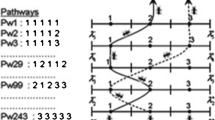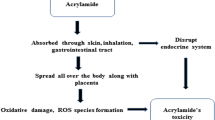Abstract
A minimal-salts medium has been optimised to support the growth of the acidophilic thermophilic bacterium Bacillus acidocaldarius. This medium was used during a study of the effect of temperature and pH on the growth rate and growth yield of this organism in batch cultures; a statistical method was used to design the experimental points, and the data were subjected to a response surface analysis which allowed the growth rate and growth yield to be predicted over the entire temperature and pH range from a minimum number of experimental points. The results indicate different responses for growth rate (optimum, 60°C, pH 4.1) and growth yield (optimum tending towards low temperature and neutral pH).
Similar content being viewed by others
Abbreviations
- NTA:
-
nitrilotriacetic acid
References
Box GEP (1954) The exploration and exploitation of response surfaces: some general considerations and examples. Biometrics 10:16–60
Cochran WG, Cox GM (1957) Experimental design Wiley, London New York, pp 335–375
Darland G, Brock TD (1971) Bacillus acidocaldarius sp nov an acidophilic, thermophilic spore forming bacterium. J Gen Microbiol 67:9–15
Egli T, Fiechter A (1981) Theoretical analysis of media used in the growth of yeasts on methanol. J Gen Microbiol 123:365–369
Kuhn HJ, Cometta S, Fiechter A (1980) Effects of growth temperature on maximal specific growth rate, yield, maintenance and death rate in glucose-limited continuous culture of the thermophilic Bacillus caldotenax. Eur J Appl Microbiol Biotechnol 10:303–315
Langworthy TA, Mayberry WR, Smith PF (1976) A sulfonolipid and novel glucosamidyl glycolipids from the extreme thermoacidophile Bacillus acidocaldarius. Biochim Biophys Acta 431:550–569
Linton JD, Harrison DEF, Bull AT (1975) Molar growth yields, respiration and cytochrome patterns of Beneckea natriegens when grown at different medium dissolved-oxygen tensions. J Gen Microbiol 90:237–246
Linton JD, Griffiths K, Gregory M (1981) The effect of mixtures of glucose and formate on the yield and respiration of a chemostat culture of Beneckea natriegens. Arch Microbiol 129:119–122
Loginova LG, Khraptsova TI, Egorova LA, Bogdanova TI (1978) Acidophilic, obligate thermophilic bacterium Bacillus acidocaldarius isolated from hot springs and soil of Kunashir Island. Mikrobiologiya (Moscow) 47:947–952
Mateles RI, Battat E (1974) Continuous culture used for media optimisation. Appl Microbiol 28:901–905
McKay A, Quilter J, Jones CW (1982) Energy conservation in the extreme thermophilie Thermus thermophilus HB8. Arch Microbiol 131:43–50
Oshima T, Arakawa H, Baba M (1977) Biochemical studies on an acidophilic, thermophilic bacterium, Bacillus acidocaldarius: isolation of bacteria, intracellular pH and stabilities of biopolymers. J Biochem 81:1107–1113
Pirt SJ (1975) Principles of microbe and cell cultivation. Blackwell, Oxford, pp 117–136
Uchino F, Doi S (1967) Acido-thermophilic bacteria from thermal waters. Agric Biol Chem 31:817–822
Author information
Authors and Affiliations
Rights and permissions
About this article
Cite this article
Farrand, S.G., Linton, J.D., Stephenson, R.J. et al. The use of response surface analysis to study the growth of Bacillus acidocaldarius throughout the growth range of temperature and pH. Arch. Microbiol. 135, 272–275 (1983). https://doi.org/10.1007/BF00413480
Received:
Accepted:
Issue Date:
DOI: https://doi.org/10.1007/BF00413480




